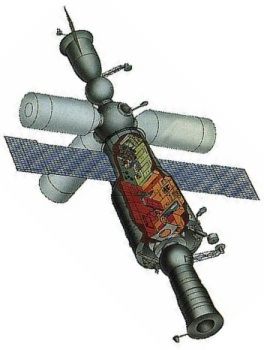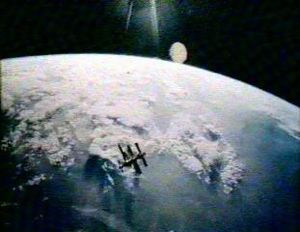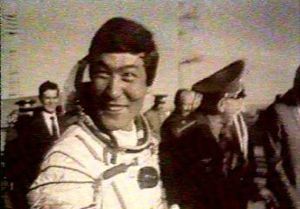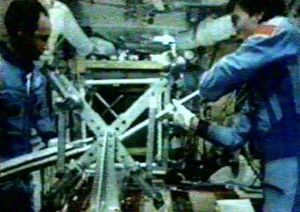
Home - Search - Browse - Alphabetic Index: 0- 1- 2- 3- 4- 5- 6- 7- 8- 9
A- B- C- D- E- F- G- H- I- J- K- L- M- N- O- P- Q- R- S- T- U- V- W- X- Y- Z
Soyuz TM-13
 Mir core Credit: NASA |
AKA: Donbass (Donbass - River Don basin);Mir EO-10;Soyuz TM-13 (Volkov Aleksandr). Launched: 1991-10-02. Returned: 1992-03-25. Number crew: 1 . Duration: 175.12 days.
Transported to the Mir manned orbital station an international crew comprising the cosmonauts A Volkov (USSR), T Aubakirov (USSR) and F. Viehbock (Austria), to conduct joint scientific and technical research with the cosmonauts A. Artsebarsky and S Krikalyov. Austria paid $ 7 million for mission. Kazakh cosmonaut added at last minute. On March 25, Volkov, Krikalyov and Flade undocked from the front port in Soyuz TM-13 and landed in Kazakhstan at 08:51 GMT on March 25.
Narrative (adapted from D S F Portree's Mir Hardware Heritage, NASA RP-1357, 1995)
Soyuz TM-13 arrived at Mir on 4 October, 1991. It carried Austrian cosmonaut-researcher Franz Viehboeck and Kazakh cosmonaut-researcher Toktar Aubakirov. The flight was unusual for carrying no flight engineer. Veteran Russian cosmonaut Alexandr Volkov commanded. The Austrians paid $7 million to fly Viehboeck to Mir, and the Kazakh cosmonaut flew partly in an effort to encourage newly-independent Kazakhstan to continue to permit launchings from Baikonur Cosmodrome. The cosmonaut-researchers photographed their respective countries from orbit and conducted the usual range of materials processing and medical experiments. Artsebarsky traded places with Volkov and returned to Earth in Soyuz TM-12. Krikalyov remained aboard Mir on his unplanned long-duration mission together with Volkov to make up the EO-10 crew.
By this time, Volkov observed, the Mir base block had suffered orbital debris and meteoroid damage on the flat sealing surface of one of its docking rings and on most of its windows. Progress M-10 broke off its first docking attempt on October 19 at a distance of 150 m. It successfully docked on October 21.
The Cosmos 1897 Altair/SR satellite drifted to 90 deg E in the geostationary belt by March. By late April the Soviets had maneuvered it back to 95 deg E, but by the end of 1991 it had drifted to 77 deg E and was widely considered inoperative. The other Altair/SR satellite, Cosmos 2054, continued to serve as a communications relay between Russia and Mir. In October the cosmonauts extended a Diagramma boom from Mir's small airlock to test the atmosphere around the station. Mir problems. The cosmonauts ended 1991 by replacing storage batteries and conducting ongoing repairs on the complex. At the end of the year total solar array power production was down to 10 kW. In addition, 4 of 6 gyrodynes on Kvant 2 and 1 of 6 gyrodynes on Kvant (5 of Mir's total of 12) had failed.
Progress M-10 topped off Mir's propellant tanks on January 13. Undocking planned for January 18 was postponed by a problem with the wiring of Mir's gyrodynes, which affected the station's attitude. When it undocked on January 20, it carried a Raduga return capsule, which was safely recovered.
On January 27, 1992 Progress M-11 arrived. The spacecraft carried a repair kit for the station's gyrodynes. During its approach to the station, flight controllers in the TsUP were on strike for higher rates of pay, but they did not interfere with the docking. Progress-M 11 boosted the complex into a 413 km by 380 km orbit before undocking. In January 1991 the fleet of ocean-going tracking ships in place since the early 1960s was phased out of Mir operations to save funds. Some of the ships continued to operate to support unmanned missions, and could step in as a backup when needed to support Mir. By mid-February, Mir was spending up to 9 hrs each day out of touch with the TsUP because of tracking system cutbacks.
On February 20 Volkov and Krikalyov opened the Kvant 2 EVA hatch for what would be Krikalyov's seventh EVA in less than a year. The heat exchanger on Volkov's Orlan-DMA spacesuit failed, forcing a hasty revision of the EVA plans. Volkov remained near the hatch, so could not operate the Strela boom to move Krikalyov to the prime work site on Kvant. Volkov assisted in installation of space exposure experiments near the hatch, then Krikalyov clambered down Kvant 2 and over the hull to Kvant. He disassembled equipment used in building the Sofora girder in July 1991, then cleaned the cameras on Kvant. Finally, he collected samples of solar cells added to the third (top) array on the base block in 1988. The EVA lasted 4 hr, 12 min.
Soyuz-TM 14 arrived on March 19. Aboard was the EO-11 crew, Alexandr Viktorenko and Alexandr Kaleri, and Klaus Dietrich Flade, who became the second German to visit a space station. The first was Sigmund Jaehn of East Germany, who visited Salyut 6 in 1978. During his six days aboard Mir, Flade conducted 14 German experiments as part of Germany's preparation for participation in the Freedom and Columbus space station projects.
Sergei Krikalyov was to have returned to Earth in October 1991, but moves to cut costs had forced modifications to his mission. A Soyuz-TM flight was cancelled, and his replacement, Alexandr Kaleri, was bumped from the Soyuz-TM 13 flight to make way for Toktar Aubakirov on the Soyuz-TM 13 flight. Krikalyov had to remain on board Mir. Western news agencies had reported that Krikalyov was stranded on Mir, though this was of course incorrect. Krikalyov, together with Flade and Volkov, undocked from Mir aboard Soyuz TM-13 on 25 March. They landed uneventfully, although NPO Energia had to pay Kazakh authorities $15,000 in rents for airports and helicopters during the recovery operation.
More at: Soyuz TM-13.
Family: Manned spaceflight. People: Volkov, Aleksandr. Spacecraft: Soyuz TM.
 | Mir in orbit Credit: RKK Energia |
 | Soyuz TM-13 Aubakirov on way to launch vehicle. Credit: RKK Energia |
 | Soyuz TM-13 Aubakirov aboard Mir. Credit: RKK Energia |
1991 October 2 - . 05:59 GMT - . Launch Site: Baikonur. Launch Complex: Baikonur LC1. LV Family: R-7. Launch Vehicle: Soyuz-U2.
- Soyuz TM-13 - .
Call Sign: Donbass (Donbass - River Don basin). Crew: Aubakirov,
Viehboeck,
Volkov, Aleksandr.
Backup Crew: Lothaller,
Musabayev,
Viktorenko.
Payload: Soyuz TM s/n 63. Mass: 7,150 kg (15,760 lb). Nation: Russia.
Agency: MOM.
Program: Mir.
Class: Manned.
Type: Manned spacecraft. Flight: Soyuz TM-12,
Soyuz TM-12 Mir LD-3,
Soyuz TM-13,
Soyuz TM-13 Austromir.
Spacecraft Bus: Soyuz.
Spacecraft: Soyuz TM.
Duration: 175.12 days. Decay Date: 1992-03-25 . USAF Sat Cat: 21735 . COSPAR: 1991-069A. Apogee: 232 km (144 mi). Perigee: 195 km (121 mi). Inclination: 51.70 deg. Period: 88.80 min.
Manned three crew. Docked with Mir. Mir Expedition EO-10. Transported to the Mir manned orbital station an international crew comprising the cosmonauts A Volkov (USSR), T Aubakirov (USSR) and F. Viehbock (Austria), to conduct joint scientific and technical research with the cosmonauts A. Artsebarsky and S Krikalev. Austria paid $ 7 million for mission. Kazakh cosmonaut added at last minute.
1991 October 17 - . 00:05 GMT - . Launch Site: Baikonur. Launch Complex: Baikonur LC1. LV Family: R-7. Launch Vehicle: Soyuz-U2.
- Progress M-10 - .
Payload: Progress M s/n 211. Mass: 7,306 kg (16,106 lb). Nation: Russia.
Agency: MOM.
Program: Mir.
Class: Manned.
Type: Manned logistics spacecraft. Flight: Soyuz TM-12 Mir LD-3,
Soyuz TM-13.
Spacecraft Bus: Soyuz.
Spacecraft: Progress M.
Duration: 95.50 days. Completed Operations Date: 1992-01-20 12:03:05 . Decay Date: 1992-01-20 12:03:05 . USAF Sat Cat: 21746 . COSPAR: 1991-073A. Apogee: 217 km (134 mi). Perigee: 185 km (114 mi). Inclination: 51.70 deg. Period: 88.50 min.
Unmanned resupply vessel to Mir. First attempted to dock with Mir on 19 October 1991. The docking was automatically aborted at a distance of 150 m from the station. Successfully docked with the forward port of Mir on on 21 Oct 1991 03:40:50 GMT. Unloading began next day. Undocked on 20 Jan 1992 07:13:44 GMT. Destroyed in reentry on 20 Jan 1992 12:03:30 GMT. Total free-flight time 4.35 days. Total docked time 91.15 days.
- VBK Raduga - . Mass: 7,450 kg (16,420 lb). Nation: Russia. Agency: UNKS. Program: Mir. Flight: Soyuz TM-12 Mir LD-3, Soyuz TM-13. Spacecraft Bus: Soyuz. Spacecraft: Progress M. Decay Date: 1992-01-20 . USAF Sat Cat: 21746 . COSPAR: 1991-073xx. Apogee: 378 km (234 mi). Perigee: 376 km (233 mi). Inclination: 51.60 deg. Period: 92.10 min.
1991 December 5 - .
- Mir News 115: Mir solar panel damaged by space debris. - .
Nation: Russia.
Program: Mir.
Flight: Soyuz TM-12 Mir LD-3,
Soyuz TM-13.
On 4 Dec. 1991 during pass in orb. 33171 (1103 UTC) Volkov spoke with a Pyotr (might have been Klimuk) about the Ukraine. Volkov made a passing reference to the fact that the crew discovered 2 small holes In one of the solar panels of Module-D. About this damage the cosmonauts spoke during the first 3 passes on 5 Dec. 1991. They made images with a TV camera, but these were not good enough for analyses. To get better images the cosmonauts had to install a special camera in the transition section (P.Kh.O.) and therefor they had to deploy and connect a cable. In Krikalyov's opinion the only way to get a good insight in the damage a space-walk (EVA) will be necessary. On 5 Dec. they spoke about 2 great holes and 1 small hole. Krikalyov even uttered the possibility that the damage has been arisen during the period in which the American Space shuttle 44, Atlantis, had to alter course to avoid a collision with the 3rd of a Soviet rocket launched long ago. So again a substantial problem for the cosmonauts. For a long time the crew are struggling with the water regeneration system Elektron and the attitude control of the complex.
During the last days Mir almost permanently remained in sunlight and for the orientation of the sensors they used sun-vectors.
DIVERTING CAPABILITIES OF THE Mir-COMPLEX IN CASE OF 'COLLISION DANGER' :
In comparison with the American (and Soviet-) Space Shuttles the Mir-station is a 'lame duck '. Even if Norad (or its Soviet opposite side) would warn Mir and TsuP for an object on collision course a quick diverting manoeuvre cannot be executed (within a few minutes). With the engines of the freighter Progress-M and the ferry Soyuz-TM the altitude of the complex can be altered, but this process lasts too long for comfort. The present crew consist of phlegmatic and crisis proof cosmonauts and they seem not to bother about this all. During radio amateur conversations they state that all is going well.
1ST STAGE ENERGIYA ROCKET BLOWN UP DURING FIRE TEST:
This news comes from a radiologist in Omsk, N. Spinov. S., also a member of the State Committee for Ecology, reported that on 20 November 1991 near the village Krutaya Gorkia (55 KM from the Siberian town Omsk) the 1st stage of the Energiya rocket exploded due to a failure in the cooling system. In a huge orange cloud the heath of the explosion dispersed and S. demands a detailed investigation for during the last years the number op persons suffering of cancer alarmingly increased.
(The 1st stage of the Energiya consists of 4 'strap on' boosters, each of which is a modified version of the 1st stage of the Zenith (SL-16) rocket. Fuel is kerosene, oxidiser LOX).
Chris van den Berg, NL-9165/A-UK3202
1992 January 19 - .
- Mir News 118: MOSCOW TIME - .
Nation: Russia.
Program: Mir.
Flight: Soyuz TM-12 Mir LD-3,
Soyuz TM-13.
For those monitoring Radio Moscow: last night Moscow time changed. The clocks have been put 1 hour forward and the new time can be considered to be an interim time. It is called: Sunlight Saving Time and will be valid until 29 March 1992. In the night from 28 to 29 March 1992 the clock will move 1 hour forward again. 50 Moscow time is now UTC+3. (TsUP, and the cosmonauts already used UTC+3 and consequently TsUP/Mir-time is now equal to Moscow time.)
ATTITUDE CONTROL FAILURE HAMPER IMPORTANT OPERATIONS.
During the last weeks preparations were going on to make the return capsule ready for a safe return to Earth. This capsule on board freighter Progress-M10 on 18 January 1992 had to separate from the then undocked Progress-MIG for a safe descent. On 16 January 1992 the cosmonauts reported failure of the Attitude Control System. On 17 January 1992 experts on TsUP were still considering what to do, but they already postponed the undocking of the Progress-M10. About the planned launch of Progress-M11 on 21 January 1992 they were not sure. Krikalyav suggested TsUP to carry out both operations and he uttered some alternatives for the attitude control. Until and inclusive 18 January 1992 Progress-M10 has not been used for an orbit correction either.
(PROGRESS-M11: The crew confirmed that Progress-M1l will not be equipped by a return-capsule. So the original plan to use such a capsule with Progress-M11 has been cancelled.
Chris van den Berg, NL-9165/A-UK3202
1992 January 25 - . 07:50 GMT - . Launch Site: Baikonur. Launch Complex: Baikonur LC1. LV Family: R-7. Launch Vehicle: Soyuz-U2.
- Progress M-11 - . Payload: Progress M s/n 212. Mass: 7,320 kg (16,130 lb). Nation: Russia. Agency: MOM. Program: Mir. Class: Manned. Type: Manned logistics spacecraft. Flight: Soyuz TM-12 Mir LD-3, Soyuz TM-13. Spacecraft Bus: Soyuz. Spacecraft: Progress M. Duration: 48.33 days. Completed Operations Date: 1992-03-13 13:13:31 . Decay Date: 1992-03-13 13:13:31 . USAF Sat Cat: 21851 . COSPAR: 1992-004A. Apogee: 227 km (141 mi). Perigee: 185 km (114 mi). Inclination: 51.60 deg. Period: 88.60 min. Unmanned resupply vessel to Mir. Docked with Mir on 27 Jan 1992 09:30:43 GMT. Undocked on 13 Mar 1992 08:43:40 GMT. Destroyed in reentry on 13 Mar 1992 15:47:00 GMT. Total free-flight time 2.36 days. Total docked time 45.97 days..
1992 February 21 - .
- Mir News 122: Mir EVA - .
Nation: Russia.
Program: Mir.
Flight: Soyuz TM-12 Mir LD-3,
Soyuz TM-13.
The EVA started on 20 Febr. 1992 at 2010 UTC and lasted until 21 Febr. 1992 at 0022 UTC. During the pass in orb. 34398, 23041 UTC, the EVA was still going on Krikalyov told TsUP that Volkov felt very well. TsUP asked for Volkov's condition for Volkov had problems with the cooling of his space-suit. The autonomous life support system in his backpack had a malfunction. He tried to cool down by hiding in the shadow, but this did not work. So he connected his spacesuit with the life-support connection near the hatch of Module-D, switched of his autonomous system and continued his work. (Press reports said that he had to go back inside the complex, but he stayed outside.) The cosmonauts removed and changed experiments with materials which had been in space for a long time. The effects of outer space on these materials, to be used for the construction of space vehicles. Krikalyov retrieved some solar cells, which had been fixed on a little experimental solar-battery. The effects of outer space on the endurance and capacity of these cells will he studied on earth. During the EVA the cosmonauts had to try to clean some windows, but they had to skip this.
During the next 3 passes (at 0037. 0213 en 0347 UTC) there was a lot of radio traffic. After his return on board Kkrikalyov was cold for a long time. He also had some skin-irritation of his hands caused by his gloves and moisture. Volkov recommended him to use a green cream. For this crew this has been the last EVA during this expedition.
RELIEF AND STAND-INN CREWS:
On February 19th, together with their German guests, these crews started their final training for the flight with Soyuz-TM14 on 17 March 1992. This final training takes place in Starcity.
Chris van den Berg, NL-9165/A-UK3202.
1992 February 21 - . 20:09 GMT - .
- EVA Mir EO-10-1 - . Crew: Krikalyov, Volkov, Aleksandr. EVA Duration: 0.18 days. Nation: Russia. Related Persons: Krikalyov, Volkov, Aleksandr. Program: Mir. Class: Manned. Type: Manned space station. Flight: Soyuz TM-12 Mir LD-3, Soyuz TM-13. Spacecraft: Mir. Dismantled equipment..
1992 February 27 - .
- Mir News 123: Russian Space Agency created - .
Nation: Russia.
Program: Mir.
Flight: Soyuz TM-12 Mir LD-3,
Soyuz TM-13.
YELSTIN SIGNED DECREE FOR THE ESTABLISHMENT OF THE R.K.A.:
R.K.A. stands for Rossiyskoe Kosmicheskoye Agentsvo, so Russian Space Agency. For a long time the Russian parliament discussed about the need to establish such an organisation. Its tasks and possibilities, but also the relation to parliament and government, are almost equal to that of the American NASA. Projects for space-operations have to be submitted to that R.K.A. The R.K.A. investigates the project and evaluates the need, necessity, costs and eventual contribution from state-funds. Projects aimed to achieve political- or chauvinistic prestige will not have any chance. After analysing a project this will be send to the parliament for consent about eventual funding. The president can put his veto on it. After consent the project will be send back to R.K.A. R.K.A. asks for offers of firms, scientific institutes, enterprises, national as well as international ones, on the basis of free enterprise and free market and selects those who will get the order(-s). After that R.K.A. has to keep control on the execution of the orders. It will take some time before such an organisation is operational and in fact it is already a little bit late.
RIDICULOUS AND EXAGGERATED INFORMATION ABOUT BAD HEALTH AND MOOD OF Mir CREW:
For a long time, more or less caused by 'glasnost' and the bad economic situation in the CIS-states, the (ex-) Soviet press critically and even with denigration reported about their national space exploration. For a few weeks that same press gradually seem to be inclined to change this policy a little bit due to a moderate positive attitude towards 'space' of Yeltsin. A lot of Russian journalists still entertain grievances about the fact, that not a Russian, but a Japanese journalist flew in a Russian space-station. Average reports about space-station Mir are still below zero and a lot these reports find their way to the West. Regretfully the spokesmen and public relations officers of space-organisations in the CIS are still very passive and miss the skill and willingness of their western colleagues to fight for their cause. Negative reports, for instance articles in Komsomolskaye Pravda, Izvestiya and others, are extra exaggerated while proceeding along western press-channels. The cosmonauts hear a lot from western news-agencies and from radio-amateurs around the world and sometimes do not believe their ears. On Febr. 17th Moscow-TV relayed a direct TV-session with Mir and the viewers could see how healthy and active the cosmonauts were. I myself know by day to day observations that the crew has a very good health and a high morale. Of course they meet problems, technical failures, even serious ones, but they always keep good hearth and in co-operation with experts on TsUP they resolve problems by repairing or replacing equipment or systems. Radio-amateurs, who have the possibility to communicate with the crew or to exchange information via Packet Radio, certainly will share my opinion. I will advise you all: take all press-reports about Mir, not with a pinch, but with some pounds of salt.
C.M. van den Berg, NL-9165/A-UK3202.
1992 March 17 - . 10:54 GMT - . Launch Site: Baikonur. Launch Complex: Baikonur LC1. LV Family: R-7. Launch Vehicle: Soyuz-U2.
- Soyuz TM-14 - . Call Sign: Vityaz (Knight ). Crew: Flade, Kaleri, Viktorenko. Backup Crew: Avdeyev, Ewald, Solovyov. Payload: Soyuz TM s/n 64. Mass: 7,150 kg (15,760 lb). Nation: Russia. Agency: MOM. Program: Mir. Class: Manned. Type: Manned spacecraft. Flight: Soyuz TM-12 Mir LD-3, Soyuz TM-13, Soyuz TM-14, Soyuz TM-14 Mir 92. Spacecraft Bus: Soyuz. Spacecraft: Soyuz TM. Duration: 145.59 days. Decay Date: 1992-08-10 . USAF Sat Cat: 21908 . COSPAR: 1992-014A. Apogee: 394 km (244 mi). Perigee: 373 km (231 mi). Inclination: 51.60 deg. Period: 92.20 min. Mir Expedition EO-11. Joint flight with Germany. Docked at the Kvant rear port at 12:33 GMT on March 19..
1992 March 25 - .
- Landing of Soyuz TM-13 - . Return Crew: Flade, Krikalyov, Volkov, Aleksandr. Nation: Russia. Related Persons: Flade, Krikalyov, Volkov, Aleksandr. Program: Mir. Flight: Soyuz TM-12 Mir LD-3, Soyuz TM-13, Soyuz TM-14, Soyuz TM-14 Mir 92. Soyuz TM-13 landed at 08:51 GMT with the crew of Flade, Krikalyov and Volkov Aleksandr aboard..
Back to top of page
Home - Search - Browse - Alphabetic Index: 0- 1- 2- 3- 4- 5- 6- 7- 8- 9
A- B- C- D- E- F- G- H- I- J- K- L- M- N- O- P- Q- R- S- T- U- V- W- X- Y- Z
© 1997-2019 Mark Wade - Contact
© / Conditions for Use